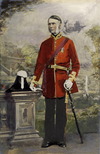LOLA, PETER (also known as Pierre or Peter Laurent), Malecite leader, guide, and runner; b. probably c. 1815 in or near Medoctec (four miles upriver from present-day Meductic), N.B.; m. 31 Oct. 1837 Fanny (Françoise) Joseph, and they had two sons and two daughters; last known to be alive in September 1852.
Beginning with William Odber Raymond*’s account in 1890, the story of Peter Lola’s foot-race with a stage-coach has become part of New Brunswick’s folklore. Some time around 1840, when he was in Fredericton, Lola requested passage in a stage-coach bound for Woodstock, a distance of approximately 60 miles. Although he offered the customary fare, he was refused. Angered, he vowed to reach the destination before the four-in-hand. Both left around eight in the morning and, despite the efforts of the coach’s driver, John Turner, Lola led the entire way over the rough New Brunswick roads. Raymond describes the conclusion of the race: “It was still early in the afternoon when the citizens of Woodstock were aroused in a manner entirely unexpected. The stage-coach came tearing into the town at the heels of an Indian who was yelling like a demon and running as for his life. . . . The finish was a close one, but the Indian was ahead.”
Unfortunately for the Malecites of the middle Saint John region, they were winners only of foot-races. Around the same time as the race took place, the members of the band were becoming increasingly concerned over the number of settlers homesteading on the site of their traditional summer village, Medoctec. This area had been allotted by the Nova Scotia authorities on 15 Oct. 1784 to 120 men from De Lancey’s Brigade, including Benjamin Peck Griffith and Robert Brown, but it was well into the 19th century before the number of permanent settlers became substantial.
In 1836, when Peter Fraser*, a Fredericton lawyer, drew up his will, he included a direction that a farm of some 200 acres, situated three miles south of Woodstock, be made a reserve for Medoctec’s displaced Indians. Fraser felt that the band should be compensated for the land of which they had been “wrongfully deprived.” The reserve was finally established on 22 May 1851, more than ten years after Fraser’s death. On 6 October, Peter Lola was one of the eight Malecites who signed the release whereby the band gave up their claim to Medoctec. John Dibblee, who was the eldest son of the Reverend Frederick Dibblee* and who, like his father, had been acquainted for some time with the Indians in the area, verified Lola’s long-standing residence at Medoctec and his right to sign the document. Lola and his family were among the old Medoctec community that moved either onto the Woodstock reserve or to a settlement at the mouth of the Meduxnakik (Meduxnekeag) River at Upper Woodstock.
An intrepid woodsman and effective guide, Peter Lola accompanied William Teel Baird* on a hunting and fishing trip in September 1852. A nostalgic account of their experiences is given in Baird’s autobiography, Seventy years of New Brunswick life. This work provides an excellent description of adventures with “rod and gun” carried out under the tutelage of Baird’s Indian guides on the lakes and rivers of central New Brunswick.
Although Peter Lola was not an important Malecite leader, the facts and legends which surround his life help to depict both the attitude of the English-speaking community of central New Brunswick towards the Malecites and the band’s response to that attitude.
Arch. paroissiales, St-Bruno (Van Buren, Maine), Reg. des baptêmes, mariages et sépultures, vol.1. PAC, RG 31, A1, 1861, Woodstock, N.B. PANB, RG 2, RS7, 40: 207. St Dunstan’s Roman Catholic Church (Fredericton), Reg. of baptisms, marriages, and burials, vol.2: 1837, no.26; 1840, no.192. Canada, Indian treaties and surrenders . . . [1680–1906] (3v., Ottawa, 1891–1912; repr. Toronto, 1971), 3: 1–3. W. T. Baird, Seventy years of New Brunswick life . . . (Saint John, N.B., 1890; repr. Fredericton, 1978). W. O. Raymond, The River St. John: its physical features, legends and history from 1604 to 1784 (Saint John, 1910; [2nd ed.], ed. J. C. Webster, Sackville, N.B., 1943; repr. 1950).
© 1985–2024 University of Toronto/Université Laval
Cite This Article
Vincent O. Erickson, “LOLA, PETER,” in Dictionary of Canadian Biography, vol. 8, University of Toronto/Université Laval, 2003–, accessed April 20, 2024, http://www.biographi.ca/en/bio/lola_peter_8E.html.
The citation above shows the format for footnotes and endnotes according to the Chicago manual of style (16th edition). Information to be used in other citation formats:
| Permalink: | http://www.biographi.ca/en/bio/lola_peter_8E.html |
| Author of Article: | Vincent O. Erickson |
| Title of Article: | LOLA, PETER |
| Publication Name: | Dictionary of Canadian Biography, vol. 8 |
| Publisher: | University of Toronto/Université Laval |
| Year of publication: | 1985 |
| Year of revision: | 1985 |
| Access Date: | April 20, 2024 |







